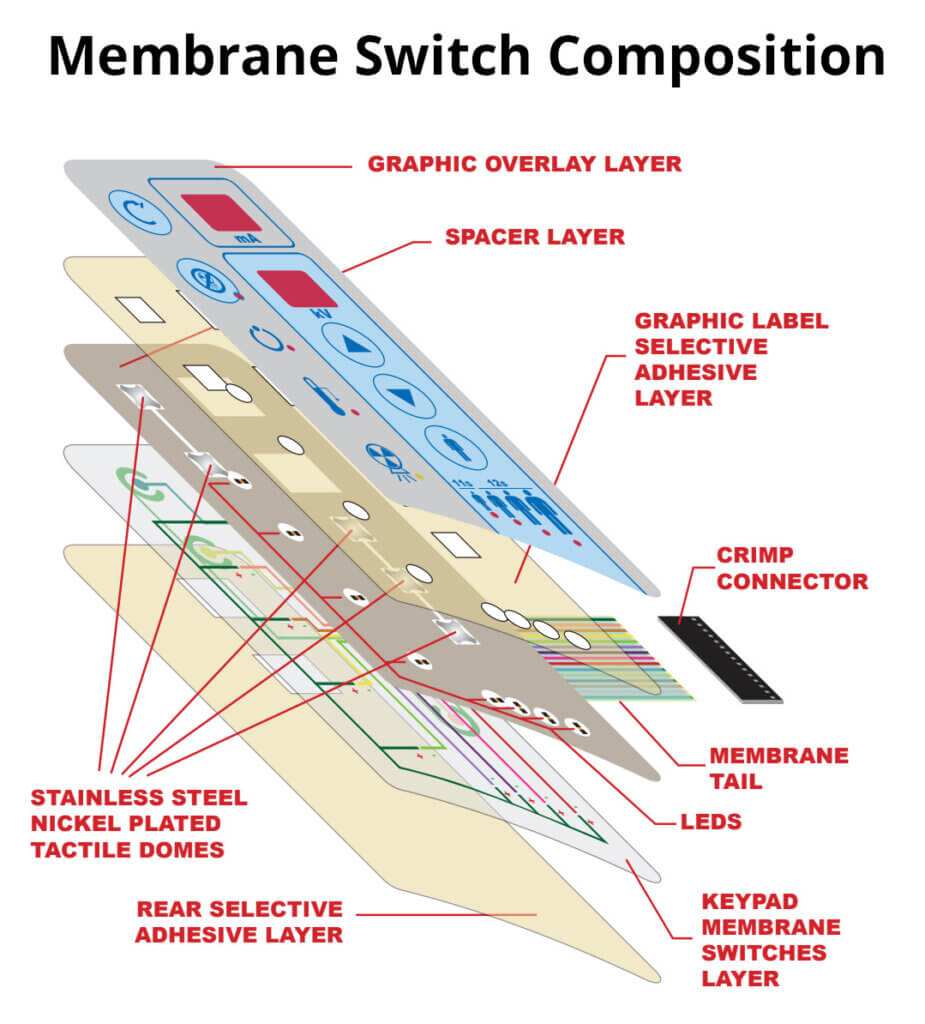Why Membrane Switches are Ideal for Durability and Performance
Why Membrane Switches are Ideal for Durability and Performance
Blog Article
Recognizing Membrane Layer Switches: The Key to Reliable and durable Controls

What Are Membrane Layer Buttons?
Membrane layer switches are an advanced solution in the world of interface modern technology, incorporating functionality and layout flawlessly. These devices function as an interface in between individuals and digital systems, integrating a number of parts right into a compact format. Typically created from flexible, slim layers of products, membrane switches are designed to react to touch, allowing individuals to interact with equipment and digital tools properly.
The main components of a membrane layer button consist of a printed circuit layer, visuals overlay, and a spacer layer that stops unintentional activation. The visuals overlay can be tailored to reflect brand name identification or user choices, boosting aesthetic appeals while ensuring use. Membrane switches are typically made use of in different applications, consisting of medical tools, consumer electronics, and industrial tools, owing to their longevity and resistance to environmental variables such as dampness and dirt.
Among the vital benefits of membrane layer switches is their capability to endure wear and tear, making them suitable for high-traffic settings. Additionally, they are light-weight and need very little space, permitting innovative styles in item advancement. In general, membrane layer changes stand for a practical and reliable option for contemporary digital user interfaces, weding innovation with user-centric style principles.
How Membrane Changes Work
The operation of membrane changes joints on a simple yet reliable device that equates customer input into digital signals. When an individual presses the button, the leading layer deforms, permitting a conductive component in the circuit layer to make contact with a matching conductive pad on the bottom of the graphic overlay.
The design of membrane switches can differ, but they typically include domes or responsive aspects to give feedback to the user, boosting the overall experience - membrane switch. The products made use of in membrane layer buttons, such as polyester or polycarbonate, add to their longevity and resistance to environmental factors, including dampness and dust. The published circuits are usually enveloped, which secures them from wear and tear over time.
Benefits of Membrane Layer Switches

Furthermore, membrane buttons are understood for their toughness. Built from robust products, they are resistant to dirt, dampness, and physical wear, which significantly extends their life-span compared to traditional mechanical buttons. This longevity makes them particularly ideal for high-traffic environments and applications requiring long life.
Another substantial benefit is the simplicity of cleaning read and upkeep. The smooth surface of membrane layer switches over decreases dust build-up and is commonly unsusceptible spills, making them ideal for settings that call for regular sanitization.
In addition, membrane buttons provide a streamlined account, bring about a thinner layout that can be incorporated into various devices without adding mass. This function not just improves the aesthetic charm however likewise adds to an extra ergonomic item style.
Applications of Membrane Layer Switches
User-friendly and flexible, membrane buttons discover applications throughout a variety of markets, including clinical devices, consumer electronics, and commercial devices. In the medical field, these switches are essential to devices such as diagnostic equipment, client monitoring systems, and mixture pumps, where reliability and convenience of cleansing are important. Their capacity to withstand harsh atmospheres and keep functionality makes them perfect for such applications.

In consumer electronics, membrane buttons are utilized in items like microwaves, cleaning equipments, and remotes - membrane switch. Their sleek style permits intuitive individual interfaces, enhancing the total individual experience while supplying resilience and resistance to tear and use
Commercial devices additionally benefits from membrane layer buttons, particularly in control panels for machinery and automation systems. These buttons provide defense against dust and wetness, making certain consistent performance in challenging environments. Their personalized features permit manufacturers to customize them to details functional needs, enhancing performance and capability.
Selecting the Right Membrane Switch Over
When picking a membrane layer button, it is important to think about various elements that influence performance and viability for particular applications. The key factors to consider include environmental conditions, responsive comments, sturdiness, and layout specifications.
First, analyze the operating setting; buttons subjected to moisture, chemicals, or extreme temperature levels require specific materials to make certain durability and performance. Next off, review the need for tactile hop over to here feedback. Depending upon customer communication, some applications might take advantage of a tactile response to validate activation, while others may prefer a non-tactile style for aesthetic reasons.
Durability is an additional essential aspect; membrane layer switches need to be created to hold up against constant usage, effects, and abrasion. Make sure the picked switch can sustain the anticipated lifecycle, specifically in high-usage circumstances.

Verdict
To conclude, membrane switches over offer as essential components in the design of trusted and resilient control systems across different markets. Their compact layout, combined with robust building and customizable attributes, improves individual communication while making certain durability in demanding environments. The versatility of membrane switches over enables customized remedies that satisfy particular functional requirements, enhancing their importance in contemporary innovation. As sectors remain to develop, the importance of integrating reliable membrane button services click over here can not be overemphasized.
Membrane layer switches represent a vital element of contemporary interface layout, mixing performance with resilience in numerous applications.Membrane layer buttons are a sophisticated option in the realm of individual interface technology, combining functionality and style flawlessly. Typically created from flexible, slim layers of materials, membrane buttons are developed to respond to touch, allowing users to communicate with equipment and electronic tools effectively.
The layout of membrane layer switches can differ, however they usually incorporate domes or responsive components to offer feedback to the customer, boosting the overall experience.In final thought, membrane layer switches serve as essential elements in the style of resilient and trustworthy control systems throughout numerous sectors.
Report this page